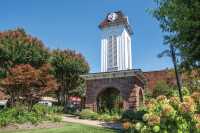Gypsies conjure memories of the past
 When I was a boy growing up in south-central Virginia during the early 1950s, my home was situated near a wooded area, one side of which was traversed by a narrow dirt road beyond which there was a natural spring.
When I was a boy growing up in south-central Virginia during the early 1950s, my home was situated near a wooded area, one side of which was traversed by a narrow dirt road beyond which there was a natural spring.
Periodically every summer a band of gypsies would suddenly show up — as if out of nowhere — set up camp alongside that road for several weeks, and then just as mysteriously disappear into thin air.
It was probably an extended family group, as there was one old couple and several younger couples, along with young people, including a baby or two, and older boys and girls my age.
They had a caboose-like vehicle painted red, with yellow trim, mounted on rubber tires. It was pulled by a team of horses and served as both a cart and a portable house. I recall that one of them also owned a mid-1930s jalopy that was jet-black.
My mother and our neighbors identified these dark-skinned sometimes gaudily-dressed people as “gypsies,” and I have no reason, in retrospect, to doubt that this was true. Each year mother warned me not to go near their camp as gypsies were prone to kidnap children and take them away forever. That warning only whetted my appetite, of course. I wasn’t, after all, absolutely sure that I didn’t want to be taken away by gypsies.
Related Items
Each summer, I would visit the camp. At their invitation, I ate lunch with them several times under the tarp. The boys, who were my age, were excellent companions when tramping through the woods. They carried slingshots with which they were exceedingly accurate. And they were every bit my equal when it came to playing baseball, which was my passion.
I can attest that neither their parents nor their grandparents ever displayed the slightest interest in taking me away with them.
So, that’s a long-winded explanation as to why I’ve always been sort of interested in gypsies. One of my favorite authors is George Borrow, who traveled with the gypsies in Europe and recorded their lifestyles in mid-nineteenth century books like Romany Rye.
I’d never supposed that gypsies ever made an appearance in Western North Carolina until, by chance, I ran across an anonymous account in the “Graham County Centennial, 1872-1972” volume titled “Gypsies in Cheoah Valley.” Here it is:
“Long before Graham County was formed from Cherokee, an old Gypsy woman and her sons with the last name of Lemming escaped from jail in Knoxville, Tennessee and made their way over the hills and mountains into Cheoah Valley. They took up their abode in an old abandoned Indian hut. Neither the old man nor the old woman nor the sons were ever seen doing any kind of work other than cooking … At first, when the Gypsies appeared at the door, the settlers gave them provisions … The old woman would arrive at the door of a cabin and ask the occupants for ham. If she was ever refused she would shake her head menacingly and mutter strange words over the soap pot. No amount of stirring, adding grease or ash lye would make the evil smelling liquid congeal.
“There upon the settler would send for the woman and give her a ham. The same thing happened to the churns. If the old woman did not receive what she asked for no amount of churning would produce butter.
“Some of the settlers took to catching chickens and having them ready and give to the Gypsies by the time they arrived at the door. Others sent provisions on ahead when they saw the old woman coming; for a rumor had gotten out that the Gypsy woman could conjure the clouds above and dry up the spring.
“It was great relief to the settlers when the wanderlust in the hearts of the Gypsies caused them to move on. They disappeared from Cheoah Valley as suddenly as they had appeared.”
“The Gypsies are coming … This is a phrase that may elicit a variety of emotions in the listener: curiosity, excitement, wariness, fear …. Gypsies were travelers. They spoke a mysterious dialect (Romani) which had its origins somewhere in India. Their presence was first noted in Western Europe in 1417 and they had been in America since colonial times. Most Gypsies had blended with the general population in subsequent years, but with the influx of immigrants from Southern and Eastern Europe in the last quarter of the 19th century, the Gypsies became a much more familiar presence on the American scene.”
— Ed Nizalowski, The Gypsies Are Coming! (1998)









